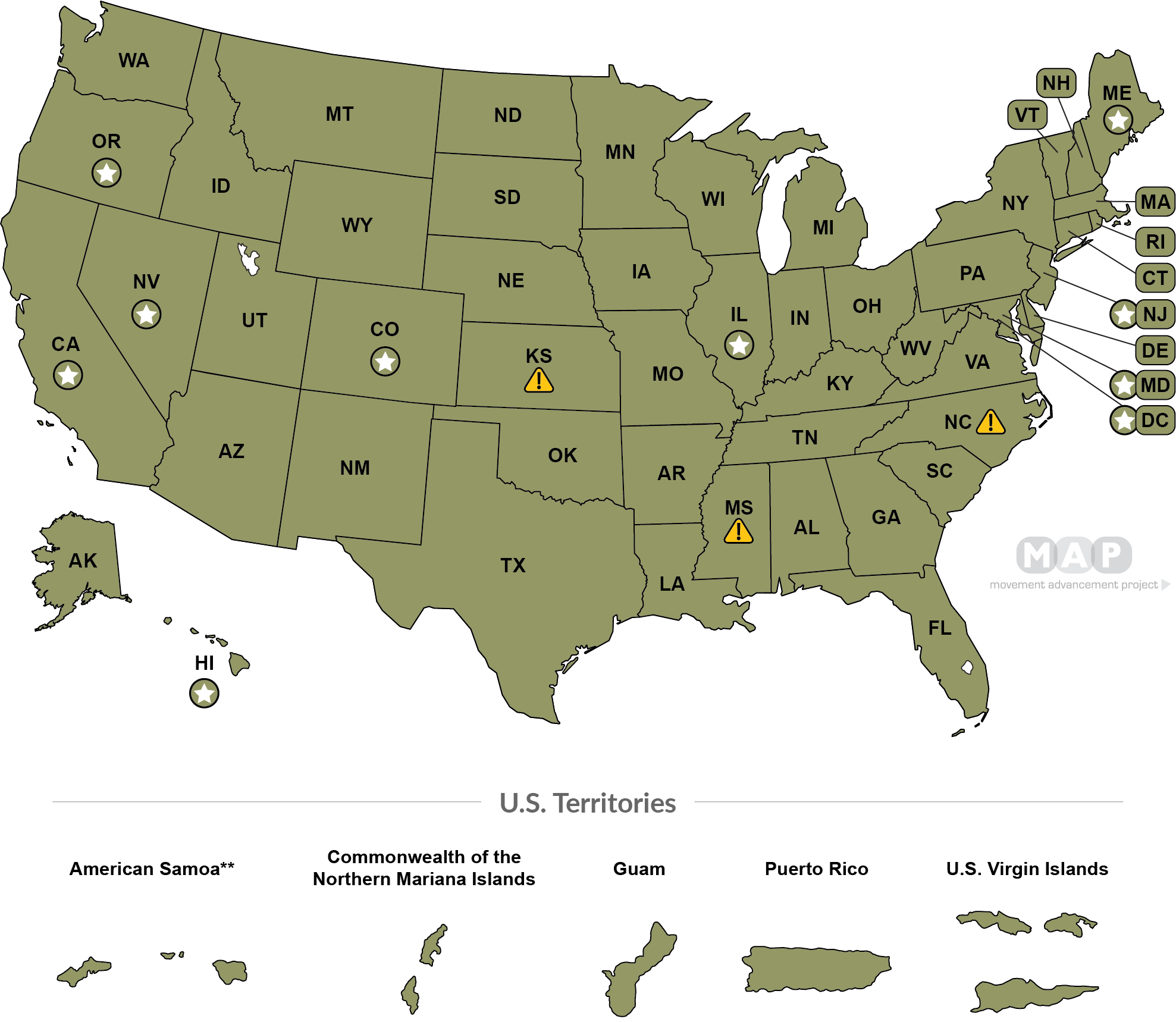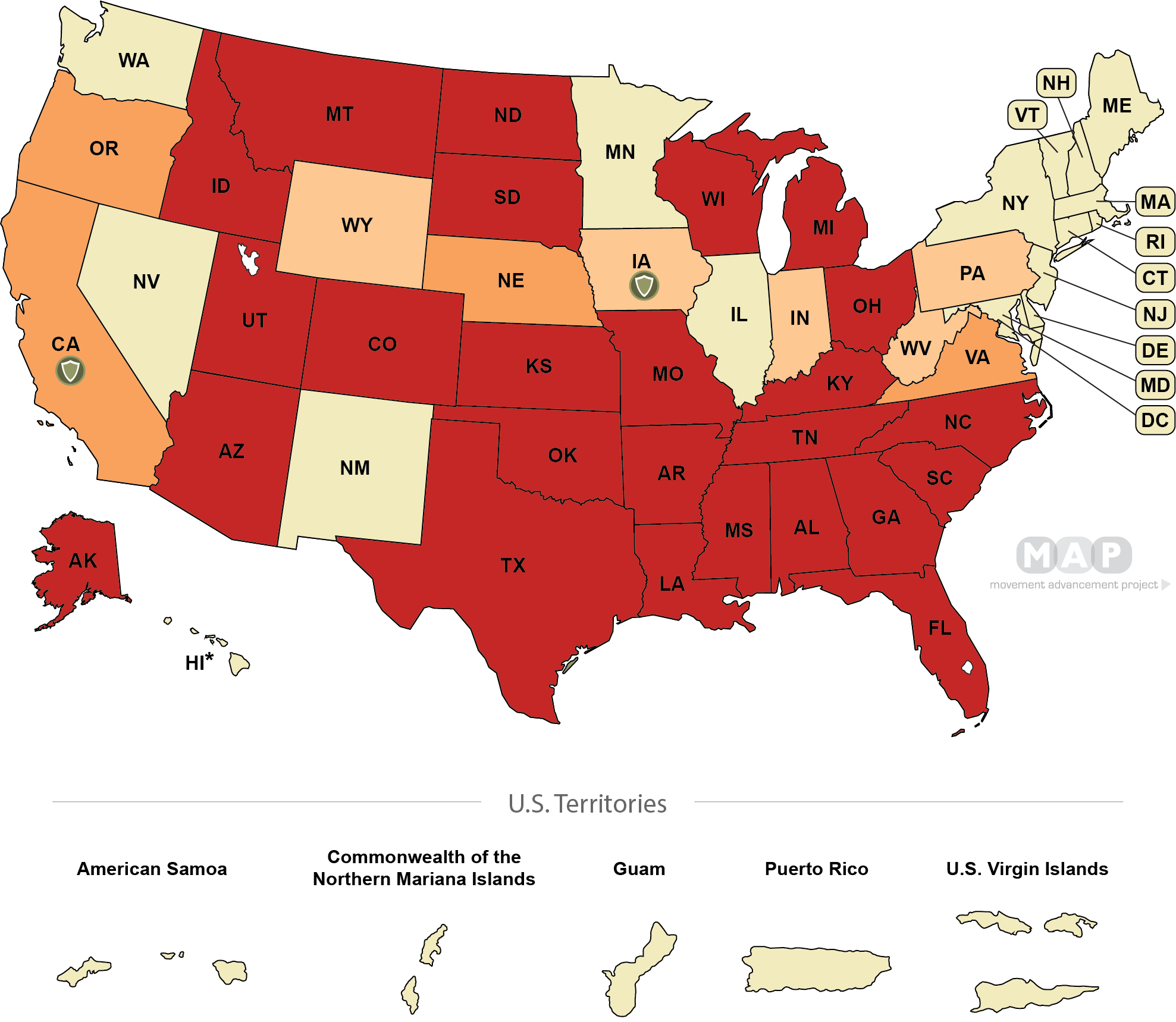States with the freedom to marry do not ban same-sex couples from entering into legal marriages. Some states also offer comprehensive relationship recognition, such as domestic partnerships or civil unions, to same- and different-sex couples. However, most states still have constitutional amendments, statutes, or both banning marriage for same-sex couples, even after the 2015 Supreme Court case Obergefell extended marriage equality nationwide. For more on the current status of state marriage laws, see MAP's 2022 report: Underneath Obergefell: A National Patchwork of Marriage Laws.
-
Marriage equality for same-sex couples
(50 states , 5 territories + D.C.)
-

Comprehensive civil union or domestic partnership law
(9 states + D.C.)
-

State has targeted religious exemption law (see note)
Recommended citation:
Movement Advancement Project. "Equality Maps: Marriage & Relationship Recognition Laws." https://www.mapresearch.org/equality-maps/recognition/marriage_relationship_laws. Accessed 04/13/2025.
NOTE: Kansas permits faith-based organizations to deny services to married same-sex couples. North Carolina permits state officials to decline to marry couples of whose marriage they disapprove. Mississippi passed a law in 2016 permitting state officials to decline to marry couples of whose marriage they disapprove; H.B. 1523 (2016); this law has been challenged and overturned by a federal court and is currently stayed from enforcement. For additional information, contact Freedom to Marry, Lambda Legal, Gay & Lesbian Advocates & Defenders or ACLU LGBT Rights Project.
The 2015 U.S. Supreme Court ruling in Obergefell extended marriage to same-sex couples nationwide. In the U.S. territories, however, there is some question as to the “on the ground” implementation of the Court’s 2015 ruling. For more information, please see MAP's U.S. territory policy spotlight.
Additionally, several Native American jurisdictions extend marriage rights to same-sex couples. These jurisdictions are federally recognized sovereign nations and therefore can create their own policies around same-sex partnerships. The following is a list of Native American nations that have legalized same-sex marriage followed by the year in which the ruling was made. Several nations passed laws to offer the freedom to marry, whereas others have issued marriage licenses to same-sex couples based on a reinterpretation of tribal codes. For more information please see: NativeOut.
- The Coquille Tribe in Oregon (2009)
- The Mashantucket Pequot Tribe in Connecticut (2010)
- The Suquamish Tribe in Washington (2011)
- The Tribal Council of the Little Traverse Bay Bands of Odawa Indians in Michigan (2013)
- The Pokagon Band of Potawatomi Indians in Michigan (2013)
- The Santa Ysabel Tribe in California (2013)
- The Colville Tribal Council of the Confederated Tribes of the Colville Nation in Washington (2013)
- The Cheyenne and Arapaho Tribes in Oklahoma (2013)
- The Leech Lake Tribal Court in Minnesota (2013)
- The Puyallup Tribe in Washington (2014)
- Tlingit and Haida Tribes in Alaska (2015)
- The Oneida Tribe in Wisconsin (2015)
- The Keweenaw Bay Indian Community in Michigan (2015)
- The Cherokee Nation (2016)
Percent of Adult LGBTQ Population Covered by Laws
*Note: These percentages reflect estimates of the LGBTQ adult population living in the 50 states and the District of Columbia. Estimates of the LGBTQ adult population in the five inhabited U.S. territories are not available, and so cannot be reflected here.
100 % of LGBTQ population lives in states with marriage equality for same-sex couples
29 % of LGBTQ population lives in states with comprehensive civil union or domestic partnership laws
Despite the 2015 Supreme Court case Obergefell, which extended marriage equality nationwide, many states still have constitutional amendments, statutes (i.e., legislation), or both banning marriage for same-sex couples. The 2015 ruling means these bans are unenforceable. For more, see also MAP's 2022 report: Underneath Obergefell: A National Patchwork of Marriage Laws. The below map is updated and maintained in real time.
Note: Currently all of these bans are unenforceable due to a 2015 U.S. Supreme Court ruling in Obergefell.
-
State has both statutory and constitutional amendment ban
(24 states)
-
State has constitutional amendment ban only
(3 states)
-
State has statutory (i.e., legislative) ban only
(5 states)
-
State has no ban on marriage equality
(18 states , 5 territories + D.C.)
-

State has court ruling protecting access to marriage for same-sex couples (independent of Obergefell)
(1 state)
Percent of Adult LGBTQ Population Covered by Laws
*Note: These percentages reflect estimates of the LGBTQ adult population living in the 50 states and the District of Columbia. Estimates of the LGBTQ adult population in the five inhabited U.S. territories are not available, and so cannot be reflected here.
47 % of LGBTQ adults live in states with both a statute and constitutional amendment banning marriage for same-sex couples
5 % of LGBTQ adults live in states with only a constitutional amendment banning marriage for same-sex couples
8 % of LGBTQ adults live in states with only a statute (i.e., legislation) banning marriage for same-sex couples
40 % of LGBTQ adults live in states with no bans on marriage equality
41 % of LGBTQ adults live in states where access to marriage equality would not change if Obergefell were struck down (states with no bans, plus states with shield icon)






